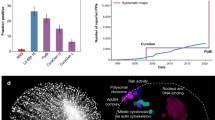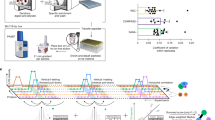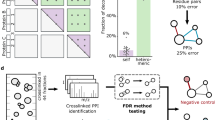Abstract
A major objective of systems biology is to organize molecular interactions as networks and to characterize information flow within networks. We describe a computational framework to integrate protein-protein interaction (PPI) networks and genetic screens to predict the 'signs' of interactions (i.e., activation-inhibition relationships). We constructed a Drosophila melanogaster signed PPI network consisting of 6,125 signed PPIs connecting 3,352 proteins that can be used to identify positive and negative regulators of signaling pathways and protein complexes. We identified an unexpected role for the metabolic enzymes enolase and aldo-keto reductase as positive and negative regulators of proteolysis, respectively. Characterization of the activation-inhibition relationships between physically interacting proteins within signaling pathways will affect our understanding of many biological functions, including signal transduction and mechanisms of disease.
This is a preview of subscription content, access via your institution
Access options
Subscribe to this journal
Receive 12 print issues and online access
$259.00 per year
only $21.58 per issue
Buy this article
- Purchase on Springer Link
- Instant access to full article PDF
Prices may be subject to local taxes which are calculated during checkout




Similar content being viewed by others
Change history
17 March 2014
In the version of this article initially published, there was an error in the expression describing the sign score Ssign. The variable Tn in the denominator should have been Tp. The error has been corrected in the HTML and PDF versions of the article.
References
Guruharsha, K.G. et al. A protein complex network of Drosophila melanogaster. Cell 147, 690–703 (2011).
Gavin, A.C. et al. Proteome survey reveals modularity of the yeast cell machinery. Nature 440, 631–636 (2006).
Krogan, N.J. et al. Global landscape of protein complexes in the yeast Saccharomyces cerevisiae. Nature 440, 637–643 (2006).
Stelzl, U. et al. A human protein-protein interaction network: a resource for annotating the proteome. Cell 122, 957–968 (2005).
Rual, J.F. et al. Towards a proteome-scale map of the human protein-protein interaction network. Nature 437, 1173–1178 (2005).
Friedman, A. & Perrimon, N. Genetic screening for signal transduction in the era of network biology. Cell 128, 225–231 (2007).
Kholodenko, B., Yaffe, M.B. & Kolch, W. Computational approaches for analyzing information flow in biological networks. Sci. Signal. 5, re1 (2012).
Hyduke, D.R. & Palsson, B.O. Towards genome-scale signalling network reconstructions. Nat. Rev. Genet. 11, 297–307 (2010).
Kirouac, D.C. et al. Creating and analyzing pathway and protein interaction compendia for modelling signal transduction networks. BMC Syst. Biol. 6, 29 (2012).
Vinayagam, A. et al. A directed protein interaction network for investigating intracellular signal transduction. Sci. Signal. 4, rs8 (2011).
Liu, W. et al. Proteome-wide prediction of signal flow direction in protein interaction networks based on interacting domains. Mol. Cell Proteomics 8, 2063–2070 (2009).
Yeger-Lotem, E. et al. Bridging high-throughput genetic and transcriptional data reveals cellular responses to alpha-synuclein toxicity. Nat. Genet. 41, 316–323 (2009).
Gitter, A., Carmi, M., Barkai, N. & Bar-Joseph, Z. Linking the signaling cascades and dynamic regulatory networks controlling stress responses. Genome Res. 23, 365–376 (2013).
Singh, R. Algorithms for the analysis of protein interaction networks. Ch. 6, 91–102 PhD thesis, Massachusetts Institute of Technology (2012).
Linding, R. et al. Systematic discovery of in vivo phosphorylation networks. Cell 129, 1415–1426 (2007).
Flockhart, I.T. et al. FlyRNAi.org—the database of the Drosophila RNAi screening center: 2012 update. Nucleic Acids Res. 40, D715–D719 (2012).
Gilsdorf, M. et al. GenomeRNAi: a database for cell-based RNAi phenotypes. 2009 update. Nucleic Acids Res. 38, D448–D452 (2010).
Neumüller, R.A. et al. Genome-wide analysis of self-renewal in Drosophila neural stem cells by transgenic RNAi. Cell Stem Cell 8, 580–593 (2011).
Mummery-Widmer, J.L. et al. Genome-wide analysis of Notch signalling in Drosophila by transgenic RNAi. Nature 458, 987–992 (2009).
Neumüller, R.A. et al. Conserved regulators of nucleolar size revealed by global phenotypic analyses. Sci. Signal. 6, ra70 (2013).
Korcsmáros, T. et al. Uniformly curated signaling pathways reveal tissue-specific cross-talks and support drug target discovery. Bioinformatics 26, 2042–2050 (2010).
Kanehisa, M., Goto, S., Sato, Y., Furumichi, M. & Tanabe, M. KEGG for integration and interpretation of large-scale molecular data sets. Nucleic Acids Res. 40, D109–D114 (2012).
Stark, C. et al. The BioGRID Interaction Database: 2011 update. Nucleic Acids Res. 39, D698–D704 (2011).
Kerrien, S. et al. The IntAct molecular interaction database in 2012. Nucleic Acids Res. 40, D841–D846 (2012).
Salwinski, L. et al. The Database of Interacting Proteins: 2004 update. Nucleic Acids Res. 32, D449–D451 (2004).
Licata, L. et al. MINT, the molecular interaction database: 2012 update. Nucleic Acids Res. 40, D857–D861 (2012).
Murali, T. et al. DroID 2011: a comprehensive, integrated resource for protein, transcription factor, RNA and gene interactions for Drosophila. Nucleic Acids Res. 39, D736–D743 (2011).
Girvan, M. & Newman, M.E. Community structure in social and biological networks. Proc. Natl. Acad. Sci. USA 99, 7821–7826 (2002).
Graveley, B.R. et al. The developmental transcriptome of Drosophila melanogaster. Nature 471, 473–479 (2011).
Facchetti, G., Iacono, G. & Altafini, C. Computing global structural balance in large-scale signed social networks. Proc. Natl. Acad. Sci. USA 108, 20953–20958 (2011).
Ma, W., Trusina, A., El-Samad, H., Lim, W.A. & Tang, C. Defining network topologies that can achieve biochemical adaptation. Cell 138, 760–773 (2009).
Vinayagam, A. et al. Protein complex-based analysis framework for high-throughput data sets. Sci. Signal. 6, rs5 (2013).
Friedman, A.A. et al. Proteomic and functional genomic landscape of receptor tyrosine kinase and ras to extracellular signal-regulated kinase signaling. Sci. Signal. 4, rs10 (2011).
Dahlmann, B. Role of proteasomes in disease. BMC Biochem. 8 (suppl. 1), S3 (2007).
Díaz -Ramos, A., Roig-Borrellas, A., García-Melero, A. & López-Alemany, R. α-Enolase, a multifunctional protein: its role on pathophysiological situations. J. Biomed. Biotechnol. 2012, 156795 (2012).
Mindnich, R.D. & Penning, T.M. Aldo-keto reductase (AKR) superfamily: genomics and annotation. Hum. Genomics 3, 362–370 (2009).
Ebert, B., Kisiela, M., Wsól, V. & Maser, E. Proteasome inhibitors MG-132 and bortezomib induce AKR1C1, AKR1C3, AKR1B1, and AKR1B10 in human colon cancer cell lines SW-480 and HT-29. Chem. Biol. Interact. 191, 239–249 (2011).
Franceschini, A. et al. STRING v9.1: protein-protein interaction networks, with increased coverage and integration. Nucleic Acids Res. 41, D808–D815 (2013).
Collins, S.R. et al. Functional dissection of protein complexes involved in yeast chromosome biology using a genetic interaction map. Nature 446, 806–810 (2007).
Fuchs, F. et al. Clustering phenotype populations by genome-wide RNAi and multiparametric imaging. Mol. Syst. Biol. 6, 370 (2010).
Venkatesan, K. et al. An empirical framework for binary interactome mapping. Nat. Methods 6, 83–90 (2009).
Shannon, P. et al. Cytoscape: a software environment for integrated models of biomolecular interaction networks. Genome Res. 13, 2498–2504 (2003).
Doncheva, N.T., Assenov, Y., Domingues, F.S. & Albrecht, M. Topological analysis and interactive visualization of biological networks and protein structures. Nat. Protoc. 7, 670–685 (2012).
Wernicke, S. & Rasche, F. FANMOD: a tool for fast network motif detection. Bioinformatics 22, 1152–1153 (2006).
Bai, J., Sepp, K.J. & Perrimon, N. Culture of Drosophila primary cells dissociated from gastrula embryos and their use in RNAi screening. Nat. Protoc. 4, 1502–1512 (2009).
Bai, J. et al. RNA interference screening in Drosophila primary cells for genes involved in muscle assembly and maintenance. Development 135, 1439–1449 (2008).
Sepp, K.J. et al. Identification of neural outgrowth genes using genome-wide RNAi. PLoS Genet. 4, e1000111 (2008).
Ranganayakulu, G., Schulz, R.A. & Olson, E.N. Wingless signaling induces nautilus expression in the ventral mesoderm of the Drosophila embryo. Dev. Biol. 176, 143–148 (1996).
Brand, A.H. & Perrimon, N. Targeted gene expression as a means of altering cell fates and generating dominant phenotypes. Development 118, 401–415 (1993).
Acknowledgements
We thank B. Housden, Y. Kwon, I.T. Flockhart and S. Rajagopal for helpful suggestions for tool development and manuscript preparation. This work was financially supported by P01-CA120964, R01-GM067761 and R01DK088718. S.E.M. is also supported in part by the Dana-Farber/Harvard Cancer Center (P30-CA06516). N.P. is supported by the Howard Hughes Medical Institute.
Author information
Authors and Affiliations
Contributions
A.V. and N.P. conceived of and designed the project. A.V. developed the computational method and built and analyzed the signed network. J.Z. designed and performed experimental validation. C.R. and B.Y. developed the SignedPPI database. A.V. and S.E.M. coordinated the development of the SignedPPI database. A.V. and Y.H. compiled RNAi screens. A.A.S. analyzed modENCODE expression data. R.A.N. contributed the unpublished RNAi screen. All authors contributed to manuscript preparation.
Corresponding authors
Ethics declarations
Competing interests
The authors declare no competing financial interests.
Supplementary information
Supplementary Text and Figures
Supplementary Figures 1–11, Supplementary Tables 1–6, 8, 9 and 11–14 (PDF 3922 kb)
Supplementary Table 7
Signed PPI network integrated with gene-expression datasets from modENCODE database (XLSX 799 kb)
Supplementary Table 10
List of triad motifs extracted from the signed network (XLSX 184 kb)
Supplementary Table 15
Signed functional interaction network constructed based on STRING interactions. Only STRING interactions with confidence score ≥ 700 is considered for the analysis (XLSX 2275 kb)
Supplementary Data
Images correspond to RNAi screen in Drosophila primary embryonic muscle cells. Each image corresponds to a single gene and a single field out of 24 fields per well. Individual image files are named as follows, gene names followed by the amplicon ID (ZIP 84492 kb)
Supplementary Software
SignPredictor tool to predict signed PPIs. (ZIP 591 kb)
Source data
Rights and permissions
About this article
Cite this article
Vinayagam, A., Zirin, J., Roesel, C. et al. Integrating protein-protein interaction networks with phenotypes reveals signs of interactions. Nat Methods 11, 94–99 (2014). https://doi.org/10.1038/nmeth.2733
Received:
Accepted:
Published:
Issue Date:
DOI: https://doi.org/10.1038/nmeth.2733
This article is cited by
-
Intrinsic limitations in mainstream methods of identifying network motifs in biology
BMC Bioinformatics (2020)
-
Domain-mediated interactions for protein subfamily identification
Scientific Reports (2020)
-
Computational intractability law molds the topology of biological networks
Applied Network Science (2020)
-
Mitochondrial genomic variation drives differential nuclear gene expression in discrete regions of Drosophila gene and protein interaction networks
BMC Genomics (2019)
-
A dual controllability analysis of influenza virus-host protein-protein interaction networks for antiviral drug target discovery
BMC Bioinformatics (2019)



